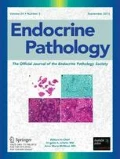Abstract
Although the production of pituitary hormones by adenohypophysial tumors has been studied extensively, an examination of the immunophenotype of pituitary adenomas using a broad spectrum of antibodies has not been previously investigated. We studied 23 pituitary adenomas using a large panel of antibodies to determine if these tumors exhibited a common immunophenotype. Various neuroendocrine markers, synaptophysin, neuron-specific enolase (NSE), and the intermediate filament protein, low-mol-wt keratin were expressed in most examples. There was, however, differential expression of chromogranin A in that few prolactin (PRL) and adenocorticotrophic hormone (ACTH) adenomas stained positively, whereas all other adenoma subtypes were reactive. The ACTH adenomas had a unique profile with positive staining for galanin, neurophysin, vasopressin, and ubiquitin. These results indicate that (1) pituitary adenomas do not express a single “generic” immunophenotype; (2) synaptophysin is the most reliable and best broad spectrum marker for pituitary adenomas; (3) the neuroendocrine granule marker chromogranin A is useful in the identification of null cell adenoma, a tumor that usually does not stain for anterior pituitary tumors; and (4) among pituitary tumors, ACTH adenomas have a unique immunoprofile.
Similar content being viewed by others
References
Kovacs K, Horvath E. Tumors of the pituitary gland. In: Atlas of tumor pathology. 2nd ser. Fascicle 21. Washington, DC: Armed Forces Institute of Pathology, 1986.
Scheithauer BW. The anterior pituitary hormones with special reference to the immunocytology of pituitary adenomas and neuroendocrine neoplasms. In: Wick MR, Siegel GP, eds. Monoclonal antibodies in diagnostic immunohistochemistry. New York: Marcel Dekker, 1988.
Hsu SM, Raine L, Fanger H. Use of avidin-biotin peroxidase complex (ABC) in immunoperoxidase technique. A comparison between ABC and unlabeled antibody (PAP) procedures. J Histochem Cytochem 29:557–586, 1981.
Asa SL, Ryan N, Kovacs K, Singer W, Marangos PJ. Immunohistochemical localization of neuron-specific enolase in the human hypophysis and pituitary adenomas. Arch Pathol Lab Med 108:40–43, 1984.
Stefaneanu L, Ryan N, Kovacs K. Immunocytochemical localization of synaptophysin in human hypophyses and pituitary adenomas. Arch Pathol Lab Med 112:801–804, 1988.
Kovacs K, Horvath E, Ryan N, Ezrin C. Null cell adenomas of the human pituitary. Virchows Arch A Pathol Anat 387:165–174, 1980.
Lloyd RV, Wilson BS, Kovacs K, Ryan N. Immunohistochemical localization of chromogranin in human hypophyses and pituitary adenomas. Arch Pathol Lab Med 109:515–517, 1985.
Le Dafniet M, Grouselli D, Li JY, Kujas M, Bression P, Barret A, Tixier-Vidal A, Peillon F. Evidence of thyrotropin-releasing hormone (TRH) and TRH-binding sites in human nonsecreting pituitary adenomas. J Clin Endocrinol Metab 65:1014–1019, 1987.
Pagesy P, Yuan Li J, Berthet M, Peillon F. Evidence of gonadotropin-releasing hormone mRNA in the rat anterior pituitary. Mol Endocrinol 6:523–528, 1992.
Tischler AS, Mobtaker IT, Mann K, Nunemacher G, Jason WJ, Dayal Y, DeLellis RA, Adelman L, Wolfe HJ. Anti-lymphocyte antibody Leu-7 (HNK-1) recognizes a constituent of neuroendocrine granule matrix. J Histochem Cytochem 34:1213–1216, 1986
Vrontakis ME, Sano T, Kovacs K, Friesen HG. Presence of galanin-like immunoreactivity in nontumorous corticotrophs and corticotroph adenomas of the human pituitary. J Clin Endocrinol Metab 70:747–751, 1990.
Kaplan LM, Gabriel SM, Koenig JI, Sunday ME, Spindel ME, Martin JB, Chin WW. Galanin is an estrogen-inducible secretory product of the rat anterior pituitary. Proc Natl Acad Sci USA 85:7400–7412, 1988.
Kimura N, Andon N, Sasano N, Sasaki A, Mouni T. Presence of neurophysin in the human pituitary corticotrophs, Cushing’s adenomas and growth hormone producing adenomas detected by immunohistochemical study. Am J Pathol 125:269–275, 1986.
Marin F, Kovacs K, Stefaneanu L, Horvath E, Cheng Z. S-100 protein immunopositivity in human nontumors hypophyses and pituitary adenomas. Endocr Pathol 3:28–38, 1992.
Hsu DW, Riskind PN, Hedley-Whyte TE. Vasoactive intestinal peptide in the human pituitary gland and adenomas. Am J Pathol 135:329–338, 1989.
Shah GV, Deftos LJ, Crowley NR. Synthesis and release of calcitonin-like immunoreactivity by anterior pituitary cells; evidence for a role in paracrine regulation of prolactin secretion. Endocrinology 132:1367–1372, 1993.
Author information
Authors and Affiliations
Rights and permissions
About this article
Cite this article
Lloyd, R.V., Scheithauer, B.W., Kovacs, K. et al. The immunophenotype of pituitary adenomas. Endocr Pathol 7, 145–150 (1996). https://doi.org/10.1007/BF02739974
Issue Date:
DOI: https://doi.org/10.1007/BF02739974




